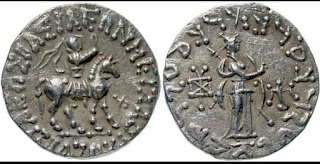Some Biblical coins are mentioned in the Bible, while few other coins have over the past centuries got associated with Jesus Christ either through research by numismatists or as they have an image of Jesus Christ on them.
The Widow's Mite. The lesson of the widow's mite or the widow's offering is presented in the Synoptic Gospels (Mark 12:41, Luke 21:1) in which Jesus is teaching at the Temple in Jerusalem. The Gospel of Mark specifies that two mites (In Jesus's time called lepta) are together worth a quadrans, the smallest Roman coin. A lepton was the smallest and least valuable coin in circulation in Judea, worth about six minutes of an average daily wage. The biblical narrative states " He sat down opposite the treasury and observed how the crowd put money into the treasury. Many rich people put in large sums. A poor widow put in two small coins". Calling his disciples, he said ' Amen. I say to you, this poor widow put in more than all others. For they have all contributed from their surplus wealth, but she, from her poverty, has contributed all she had, her whole livelihood'.
The Tribute Penny. This was the coin showed to Jesus when he made the famous speech "Render unto Caesar." In Matthew 25:15-21, a Jewish high priest tries to trick Jesus into a statement of treason by inquiring whether it was lawful to pay tribute to Caesar. Jesus knew their evil intent and said, 'Show me the tribute money'. They brought him a penny. Then he asked them " Whose is the image? And whose superscription? They answered, Caesar's. Aware of the priests' plot, he said, "Render therefore unto Caesar the things which are Caesar's and unto God the things that are God's. It was called a penny because in 1611, when the Bible was translated into King James version, the British word penny replaced Denarius. The penny in those days was abbreviated as d. (for Denarius)
There is much debate over which coin Jesus was describing. Although there are a number of possibilities, numismatists after a lot of research have traditionally identified the standard silver denarius of Tiberius (14 AD-37 AD) as the most likely one.
The Tribute Money
Thirty Pieces of Silver. Matthew 26:15-16, 27:3 and 27:5-6 describe how thirty silver coins were promised to Judas Iscariot to betray Jesus." Then one of the twelve, called Judas Iscariot, went unto the chief priests, and said unto them, what will ye give me, and I will deliver him unto you? And they covenanted with him for 30 pieces of silver" Matthew 26:14-15. After the deed Judas sank into remorse and cast aside the coins he had received. These events are significant to Biblical history, and it is generally accepted that the coins paid to Judas were shekels from the mint of Tyre, a coastal city in Phoenicia. At that time in history Tyre was the only producer of high purity silver coins in the region, and it is unlikely that any other coin, including Roman tetradrachms, which were debased silver would fit the description. At that time Jews paid their annual half shekel contribution to the Jerusalem temple in its only accepted form, silver coins of Tyre.
Bronzes of Pontius Pilate. As related in John 18:33-35 and in Matthew 27;1-2, 27:22-26 and 27:57-58, Pontius Pilate, the notorious Roman procurator of Judaea was a central figure in the arrest, trial and crucifixion of Christ. Though none of the small bronzes issued bear his name, they do have the dates that allow their attribution. The Greek inscriptions indicate that Tiberius was the reigning emperor of Rome. The dates include the 16th to 18th year of rule of Tiberius, AD 29 to 31. Even though Pilate's was appointed governor of Judea in 26 AD, his governorship lasted ten years, but local coinage was produced for just these three years.
Star of Bethlehem Coin. Astronomer and a Numismatist Michael Molnar, believes a bronze coin of Roman Syria, issued by Quintus Caecillius Metellus Creticus Silanus, who was governor of Syria from 13 AD to 17 AD, depicts the celestial events described as the Star of Bethlehem. Molnar presents the case in his book titled 'The Star of Bethlehem: The Legacy of Magi' published in 1999, which has now been translated into several languages. He relates this coin to the birth of Christ and presents his research in astronomical calculations, that I too seem to get convinced.
Azes Coins . The biblical story of the three wise men appears in the New Testament, Matthew 2:1-12. It speaks of three wise men who came from the East, bearing gifts. According to Matthew, they were guided by a star to Jerusalem, the birthplace of Jesus. It is now widely acclaimed by historians that the silver tetradrachm coins of Azes II, who reigned from 35 BC to 5 AD, and who was the last Indo-Scythian king in Northern India signify the representative he sent to the holy land seeking the birth of the Christ child and the individual may have been one of the three wise men (Magi).
Byzantine Empire coins with Christ's image. This empire was the continuation of the Roman Empire in its eastern provinces during the Middle Ages. Its capital was Constantinople (present day Istanbul, formerly Byzantium). It survived the fall of the western Roman Empire in the 5th century AD and continued till it fell to the Ottoman Empire in 1453.
Christ's image appeared on the coinage during the first reign of Justinian II (685 AD to 695 AD) about 250 years after Christianity became the state religion of the Romans. The most familiar images of Christ occur on copper follis of the 10th and 11th centuries AD, which were described as 'anonymous' because the image of Christ and the inscription dedicated to him replace those that formerly had been devoted to the emperor.
Byzantine Scyphates. Later in the 11th and 12th centuries scyphate (cup shaped) coins known as Trachy were issued in both electrum (gold based) and billon (debased silver). The exact reason for such coins is not known, though generally theorized that they were easy to stack in this shape.
Alexius III, Angelus-Comnenus, 1195 AD - 1203 AD, billon aspron Trachy " Scyphate", weight 1.62 gm, Obverse: Bust of Christ facing, wearing nimbus, pallium and columbarium, holding scroll and raising hand in benediction, Reverse; Alexius and St Constantine holding cross and labarum.
Biblical coin of Herod Agrippa. He was the grandson of Herod the Great. He was born in 11 BC and was just a few years older than Christ. The coin includes the name "Agrippa' in Greek and three branches of wheat, representing the third generation of the Herodian dynasty. His friend Emperor Caligula, of Rome granted him amongst other territories, Judea too.


















Fantastic post. So enjoyed the historical documentary along with the coins.
ReplyDeleteAlpana
Highly informative and a different perspective of looking at my SAVIOUR JESUS CHRIST - WHO clarified and helped the world discern what belongs to eternity and what's ephemeral.
ReplyDeleteThank you very much Sir for this Study.